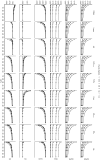Sample size for binary logistic prediction models: Beyond events per variable criteria
- PMID: 29966490
- PMCID: PMC6710621
- DOI: 10.1177/0962280218784726
Sample size for binary logistic prediction models: Beyond events per variable criteria
Abstract
Binary logistic regression is one of the most frequently applied statistical approaches for developing clinical prediction models. Developers of such models often rely on an Events Per Variable criterion (EPV), notably EPV ≥10, to determine the minimal sample size required and the maximum number of candidate predictors that can be examined. We present an extensive simulation study in which we studied the influence of EPV, events fraction, number of candidate predictors, the correlations and distributions of candidate predictor variables, area under the ROC curve, and predictor effects on out-of-sample predictive performance of prediction models. The out-of-sample performance (calibration, discrimination and probability prediction error) of developed prediction models was studied before and after regression shrinkage and variable selection. The results indicate that EPV does not have a strong relation with metrics of predictive performance, and is not an appropriate criterion for (binary) prediction model development studies. We show that out-of-sample predictive performance can better be approximated by considering the number of predictors, the total sample size and the events fraction. We propose that the development of new sample size criteria for prediction models should be based on these three parameters, and provide suggestions for improving sample size determination.
Keywords: EPV; Logistic regression; prediction models; predictive performance; sample size; simulations.
Figures




References
-
- Moons KGM, Altman DG, Reitsma JB, et al. Transparent reporting of a multivariable prediction model for individual prognosis or diagnosis (TRIPOD): explanation and elaboration. Ann Intern Med 2015; 162: W1–W73. - PubMed
-
- Collins GS, Reitsma JB, Altman DG, et al. Transparent reporting of a multivariable prediction model for individual prognosis or diagnosis (TRIPOD): the TRIPOD statement. Ann Intern Med 2015; 162: 55–55. - PubMed
-
- Altman DG, Royston P. What do we mean by validating a prognostic model? Stat Med 2000; 19: 453–473. - PubMed
-
- Moons KGM, Kengne AP, Grobbee DE, et al. Risk prediction models: II. External validation, model updating, and impact assessment. Heart 2012; 98: 691–698. - PubMed
Publication types
MeSH terms
Grants and funding
LinkOut - more resources
Full Text Sources
Other Literature Sources
Medical

